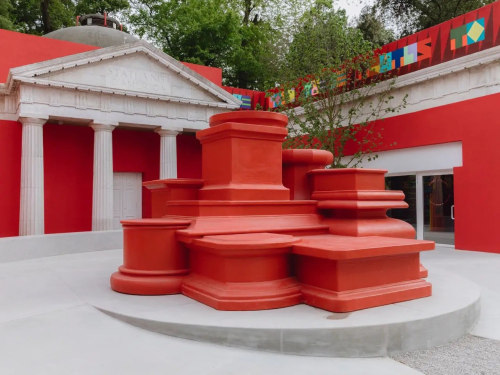

Curator Adriano Pedrosa’s theme for the 60th International Exhibition of La Biennale di Venezia is Stranieri Ovunque (Foreigners Everywhere). The Biennale’s title is drawn from a series of works made by the Paris-born and Palermo-based collective Claire Fontaine since 2004, which consist of neon sculptures made in more than 50 different languages, including indigenous languages, featuring the expression Foreigners Everywhere.
The neon sculptures are exhibited at the Gaggiandre shipyards in the Arsenale and in the Giardini central exhibition. The expression Foreigners Everywhere was originally appropriated from the name of Stranieri Ovunque, a Turin collective who fought racism and xenophobia in Italy in the early 2000s.
“Artists have always travelled and moved about through cities, countries and continents. The Biennale Arte 2024’s primary focus is thus artists who are themselves foreigners, immigrants, expatriates, diasporic, emigres, exiled, or refugees.” Adriano Perosa
In the central exhibitions of the Biennale Arte there is an emphasis on artists from the global South and indigenous art, and indigenous Artists Archie Moore and the Mataaho Collective were awarded Venice’s Golden Lions, with Moore winning best national pavilion for Australia (the country’s first Gold Lion). Moore spent months coating the exterior of the Pavilion with blackboard paint then applying chalk drawings to trace relationships between people and place back for 65,000 years. He references Australia’s cultural heritage, erased histories and the first nation people of Australia who are one of the oldest living cultures.
The Central Stranieri Ovunque exhibitions spread over two vast sites – the Giardini, where there are around 30 National Pavilions, and the Arsenale, a former ship-building yard. There are around 300 artists exhibiting in the central exhibitions with 88 National Participations. Major museum exhibitions and official collateral events as well as vanity projects of collectors and galleries are dotted around the city. Although the national pavilions of the Biennale don’t have to adhere to the central theme and have autonomy to select an artist to represent their country, there is an overwhelming sense that most countries are presenting artists whose work responds to the Stranieri Ovunque theme.
Indigenous artists are representing USA, Brazil, Denmark and Australia, while diasporic artists or artists from countries that have been colonized are representing some countries, with Spain represented by an artist from Peru and the Dutch Pavilion exhibiting the work of a collective from the Congo, perhaps in a gesture of reparation for Colonization.
Curated by Kathleen Ash-Milby, Abigail Winograd, the USA Pavilion in the Giardini is dedicated to the breathtaking art of Jeffrey Gibson, a member of the Mississippi Band of Choctaw Indians and of Cherokee descent. Multi-disciplinary artist Gibson has created a truly joyful and immersive experience that commences before entering the USA Pavilion, by enveloping it’s classical façade with his rainbow coloured, geometric designs, and uplifting mantras.
Inside the Pavilion is infused with more colour and joy, with intricately beaded and costumed figures inspired by indigenous American tribal aesthetics, and paintings featuring Gibson’s signature geometrical shapes and unique rainbow-coloured font. His mantras include phrases such as ‘If not now then when’, ‘Give my life something extra’ and ‘If you want to lift yourself up, lift up someone else.’ While he references civil injustices against minorities and indigenous American people such as the 1970-71 enforcement acts, his message is one of hope for a more equal and humane society in the future.
He visualises “a space in which Indigenous art and a broad spectrum of cultural expressions and identities are central to the American experience.” Gibson has created an interdisciplinary practice and hybrid visual vocabulary by drawing on American, Indigenous, and queer histories, with references to popular subcultures, literature, and global artistic traditions. His artistic practice reflects the vibrant realities of Indigenous communities in the United States, a form of cultural critique that engages with complex histories rather than erasing them.